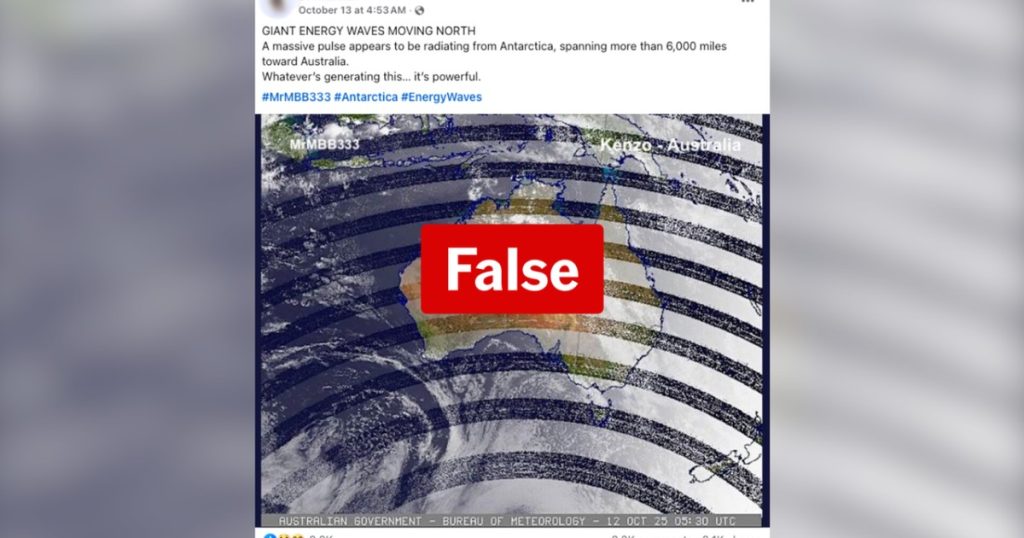Listen to the article
No “Mystery Energy Waves” From Antarctica, Satellite Glitch to Blame
Claims of massive energy waves radiating from Antarctica toward Australia have been debunked after investigation revealed they were simply the result of a technical malfunction in a Japanese weather satellite.
Social media posts circulating this week sparked concern and conspiracy theories when users shared what appeared to be satellite imagery showing strange, curved white lines emanating northward from Antarctica toward Australia. One viral post declared: “GIANT ENERGY WAVES MOVING NORTH,” and claimed that “a massive pulse appears to be radiating from Antarctica, spanning more than 6,000 miles toward Australia.”
The image in question, dated October 12, 2025, at 05:30 UTC, contained the caption “AUSTRALIAN GOVERNMENT BUREAU OF METEOROLOGY,” lending an air of official credibility to the unusual phenomenon.
However, the Bureau of Meteorology has confirmed to AAP FactCheck that the anomalous wave patterns were not real atmospheric or geological events, but rather the result of a technical failure in the Himawari-9 satellite.
“The Bureau of Meteorology is aware of issues that impacted the Himawari-9 satellite on 12-13 October 2025,” a spokesperson told fact-checkers.
The Himawari-9 geostationary satellite, which is operated by the Japan Meteorological Agency (JMA), serves as a critical tool for weather forecasting across Australia and the Asia-Pacific region. It provides real-time imagery that meteorologists use to track weather systems, monitor severe storms, and develop forecasts.
The JMA had already noted problems with the satellite, releasing a statement acknowledging the anomaly in Himawari-9’s image data. As a precautionary measure, the agency switched operations to the backup Himawari-8 satellite on October 11, 2025, just a day before the glitched images began circulating online.
“We apologize for any inconvenience,” the JMA statement said, confirming the technical nature of the issue.
Further evidence that the “energy waves” were merely a satellite malfunction comes from comparative imagery. When examining data from other satellites monitoring the same geographic region during the identical time period, no unusual wave patterns appear. The Korean Meteorological Administration’s Geo-Kompsat-2A satellite, which also covers Australia and surrounding waters, showed normal atmospheric conditions with none of the dramatic wave patterns visible in the Himawari-9 imagery.
The U.S. National Oceanic and Atmospheric Administration (NOAA) also noted the Himawari-9 outage in their operational bulletins, confirming the technical nature of the anomaly.
This incident highlights how easily satellite glitches can be misinterpreted and transformed into sensational claims on social media. Weather satellites occasionally experience technical issues that can produce unusual artifacts in their imagery. These anomalies can appear as lines, waves, or other patterns that don’t represent actual atmospheric conditions.
For meteorological agencies worldwide, satellite redundancy is crucial for this very reason. The ability to switch from Himawari-9 to Himawari-8 allowed for continuous monitoring of weather systems across the Asia-Pacific region despite the technical failure.
The Bureau of Meteorology relies on satellite data for forecasting across Australia’s vast territory, particularly in remote regions where ground-based observations are limited. Any disruption to satellite services can potentially impact the accuracy of weather forecasts, making backup systems essential.
This case serves as a reminder for the public to verify unusual claims with official sources before assuming extraordinary phenomena are at work. While technical glitches may occasionally produce striking visual anomalies, they rarely indicate mysterious energy pulses from Antarctica or other sensational explanations that quickly gain traction online.
Verify This Yourself
Use these professional tools to fact-check and investigate claims independently
Reverse Image Search
Check if this image has been used elsewhere or in different contexts
Ask Our AI About This Claim
Get instant answers with web-powered AI analysis
Related Fact-Checks
See what other fact-checkers have said about similar claims
Want More Verification Tools?
Access our full suite of professional disinformation monitoring and investigation tools




8 Comments
While eye-catching satellite imagery can be intriguing, it’s critical to verify the information before jumping to conclusions. I’m glad the true cause of these ‘energy waves’ was identified and debunked through proper investigation. Fact-checking is vital, especially on social media.
It’s always important to approach sensational social media claims with a critical eye. I appreciate the fact-checking work done here to separate truth from fiction. Maintaining public trust in scientific institutions is crucial, especially when it comes to monitoring the environment and weather patterns.
Agreed. Relying on official sources and verified information is key to avoiding the spread of misinformation, especially around sensitive topics like natural phenomena. Kudos to the Bureau of Meteorology for their transparency.
This highlights the importance of relying on authoritative and verified sources, rather than unsubstantiated claims circulating online. I commend the Bureau of Meteorology for their swift response in clarifying the technical nature of the satellite anomaly. Maintaining public trust in science and institutions is key.
Fascinating to see how a technical glitch in satellite imagery can spark wild conspiracy theories. I’m glad the Bureau of Meteorology was able to debunk these ‘giant energy wave’ claims quickly and transparently. Satellites are complex pieces of equipment, and glitches do happen from time to time.
Interesting to see how a simple satellite glitch can spiral into wild conspiracy theories. I appreciate the Bureau of Meteorology stepping in to provide the facts and restore trust in the integrity of their data. Transparency around technical issues is crucial for maintaining public confidence.
It’s fascinating to see how quickly misinformation can spread, even when the source appears to be official. I’m glad the Bureau of Meteorology was able to promptly address this issue and provide the true explanation. Fact-checking is crucial in our digital age to combat the spread of conspiracy theories.
This is a good reminder that not everything we see online, even if it looks official, is necessarily accurate. I’m glad the true cause of the ‘energy waves’ was identified as a technical malfunction rather than some kind of ominous geological event. Rigorous fact-checking is so important these days.